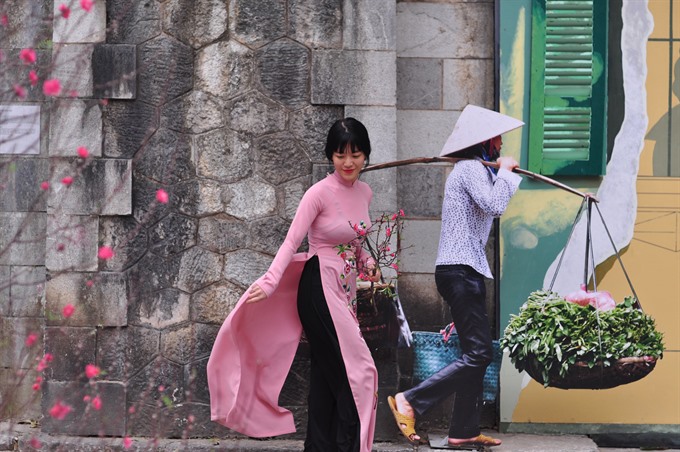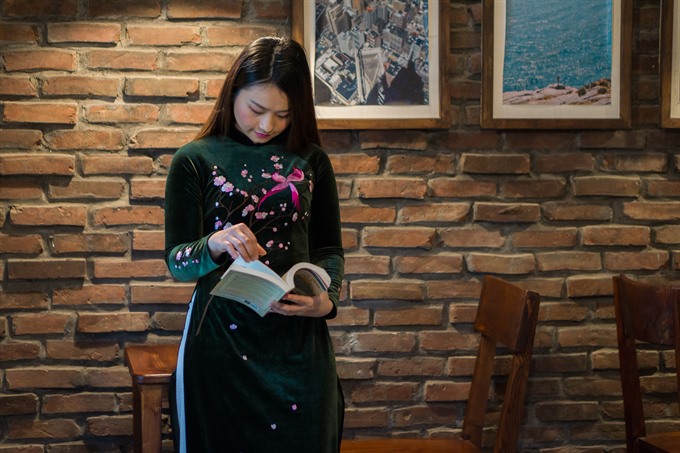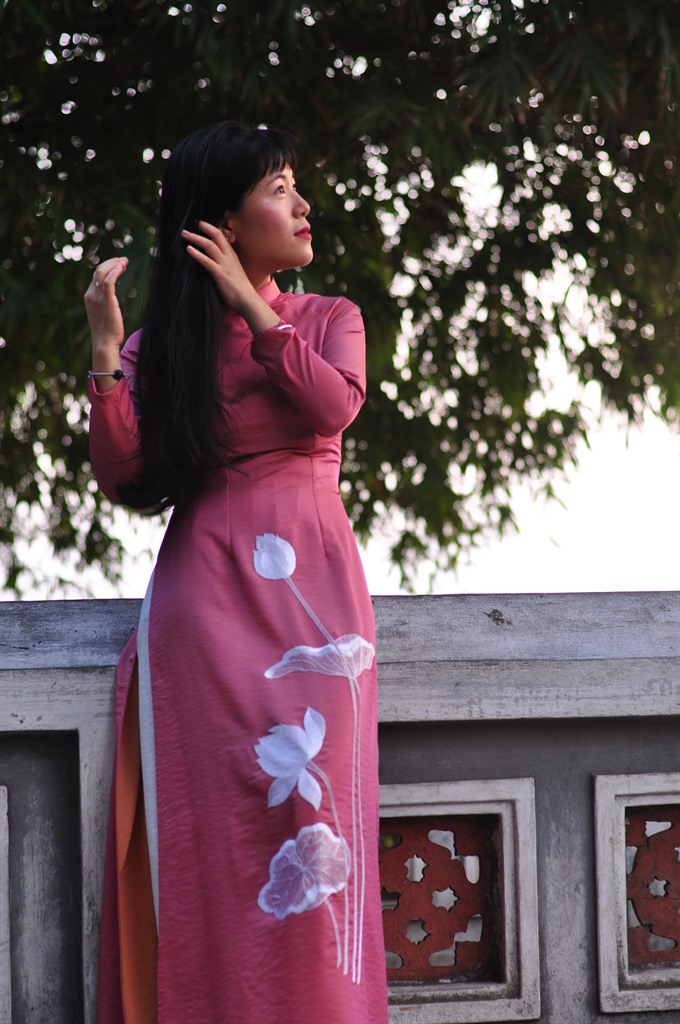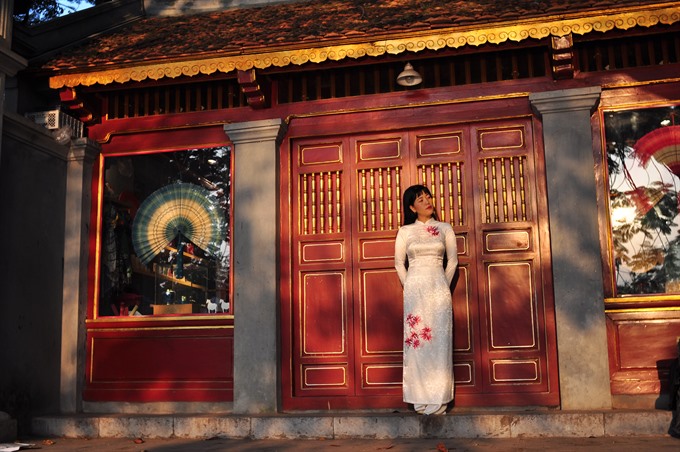 |
| Au naturale: Naturally died silk needs to be treated to keep the colour last longer. |
Viet Nam News
Since Viet Nam became a republic in 1945, many craft villages have moved away from their traditional sources of income. One start-up business is trying to update and maintain the 300-year-old craft of embroidery to meet contemporary needs. Nguyen My Ha reports.
In the two months leading up to Tet, the Lunar New Year, the fashion houses across the country launch their latest ao dai collections for the year.
Women of all ages busily prepare one of their most special costumes of the year, second only to the ones they wear for the wedding of a family member.
If the fashion world has two collections – one for Spring/Summer and one for Autumn/Winter – then many Vietnamese designers tend to have three each year: the same two collections, and one just for ao dai.
Ao dai can fit all women
People often think a delicate outfit like ao dai can be hard to wear, because you are supposed to show the body under a couple layers of thin silk or velvet. But actually, the free flow of the drapes make it fit any body type and the long sleeves and long trousers make it safe to wear if you don’t want to expose your skin.
Among all the ao dai, the most sophisticated ones are embroidered, with each image bearing a message or goal for the person wearing it.
When Viet Nam was a kingdom, many villages survived by filling the wardrobes of the King, his wife and his contingent of concubines. Since Viet Nam became a republic in 1945, these traditional villages switched to making ornate embroidered tablecloths, napkins, embroidered paintings and duvet covers, or kimonos, small gift boxes and bags.
Besides rice farming work, the livelihoods of these artisans depend on the export orders they receive.
“My parents only wanted me to go to school, go to college, get a job as an office worker and settle down,” says Bui Mai Lan, 35, founder of the Tu Thi Hand Embroidery company. “They did not want me to follow the traditional craft of our village because they both think it’s all hard work and low pay. All they wanted for me was to be a government employee to get a pension when I retire.”
Quat Dong, cradle of embroidery
Lan says she was lucky to have grown up in Quat Dong Village in a land of more than 200 craft villages in the Ha Tay region.
“Every family in my village used to have several frames for embroidery,” she says. “During summer when we went there from our Ha Noi house, I saw my uncles and cousins embroidering all the time.”
It was as natural a part of life as breathing. Lan says she had a happy childhood playing in her country home and watching her family sewing. They would take a break to prepare a meal, then go back to work together again.
One day, hanging around the masters of the craft, the little girl received an offer: “Want to try it?”
So she did. From early on, children learned to make simple stitches. The first detail they were allowed to sew was the water in a larger dragon painting.
“I started out with water, then I did clouds,” she says. “Then I got to do each segment of the dragon’s long body. And the adults would meticulously sew the dragon scales.”
“Sometimes, when they worked on a large painting, six or seven people would sit around a frame working at the same time to make a landscape painting or one that has dragons, kylins, turles and phoenixes, the ancient sacred symbols. The overall ambience was really busy and happy,” she says.
“During my childhood, I could see the better time of the village was around 2001 to 2005, when orders from Japan to make kimonos and orders to from South Korea to make tablecloths kept villagers busy.”
Lan says she did exactly what her parents wanted her to do. She studied well, finished college and got a job as a journalist at Radio the Voice of Viet Nam. To many of her fellow villagers, and her cousins who stayed to work as craftspeople, it was a dream job to have – if you do not make any grave mistakes, you are on the right track to get your pension upon retirement.
But since 2005 her village has received fewer orders year by year, so many families have opted for other ways to make ends meet. Since 2010, there was a little vogue of cross stitch works that people were enthusiastic about. But to Lan, it was not the real embroidery she used to know.
“The more I went to my village, the more I had to see our family’s beloved old things being lost,” Lan says.
“I treasure my memory, and that of our family, of our village’s craft. My younger cousins also loved it and I want to keep the line going.
“So I asked myself, why don’t I go back to doing embroidery?”
Lan started thinking about it more seriously in 2017. “But I was still very scared. Because I went to work right after college graduation, I did not know anything about business or the balance sheet. I always made mistakes doing maths, let alone trying to make some profit by counting costs and turnover.”
Lan wasn’t convinced she would change careers, until a family anniversary for an ancestor that changed her mind for good.
As a family deeply rooted in the village life of the country, Lan says her family has many anniversaries to worship ancient ancestors throughout the year.
Two years ago around this time of year, she went home to see her father discarding her family’s own embroidered wooden and bamboo frames, including some from her grandparents’ time.
“Dad, what are you doing?” She asked. “I’m throwing them away,” he said. “They are all rotten, eaten up by wood borers. They would eventually eat up our other furniture. I’m burning them up, as firewood to cook!”
 |
| Bookworm: Tet collection lookbook. Photos courtesy of Tu Thi |
 |
| Grind: Hand embroidery requires many hours of work. |
 |
| Each to their own: Customised design provides customers with unique look. |
Keeping the craft alive
Lan made a very smooth transition from working as a journalist to starting up her business. She brought some embroidery samples to work and showed her colleagues, who ordered some for themselves and became the first customers of her start-up. Word of the beautiful pieces of clothing travelled fast and in no time she was overloaded with orders.
Ha Trang, another journalist with design talent, worked with her for a few months.
“I thought I could not split myself between my daily beat as a journalist and managing my business, so I left to found Tu Thi Hand Embroidery,” Lan says. “Deep inside, I still love the nature of writing, so I now write content for my brand.”
Ha Trang also quit her job one month later to work full time in the business, taking care of the designs for Tu Thi.
“What I brought up has started burning like fire!” she says in her home on a tiny alley in the Old Quarter. The old frames were not burnt to ashes, but they helped light a match in her head.
The first few months were tough, she said. She spent all her salary from her previous job to pay the workers. “At first, they demanded that I pay them right away,” she said. “Now I beg them to take the money, and they tell me to save it for Tet and they’ll take it all at once.”
Lan says everything needs time to process and develop. “If you continue to work hard on it, then it will only get better!”
Tu Thi Hand Embroidery shop has tried to save costs by using Lan’s home for the office.
“Right now, we are based here,” Lan says. “But in the future, we will think about longer term offices.”
“We do have a policy, which is that we refuse to copy design from other shops,” she says. “Some customers may see a beautiful design and they want our shop to make the same for them; I made it our policy to flatly refuse.”
By following this policy, Lan says she and her company respect the creative work of others, and promote her own company’s designs.
For Tet, Ha Trang has come up with new designs of little pink pigs, which are also birth sign animal for both of the founders. "I go to night design classes for further training to offer customised drawings for clients," she says.
Choosing better quality fabric is important to their company. They came up with their own designs for the Spring/Fall collections on Vietnamese silk made in Van Phuc here in Ha Noi, Ma Chau in Hoi An or Bao Loc in Lam Dong Province.
“We are geared towards making a product that is ‘Made by Viet Nam’, instead of ‘Made in Viet Nam.’” — VNS
Fabled past
Quat Dong master embroiderers were believed to be some of the best in the country since the 17th century. According to memorial stelae at Ngu Xa Village in Ha Noi, Quat Dong Village in Ha Tay and Tu Thi Temple in Ha Noi, laureate of the royal exam Dr Le Cong Hanh (whose real name was Bui Cong Hanh) was the founding father of embroidery craft in the country.
Living from the late Tran Dynasty until the early Le Dynasty in Quat Dong, Bui Cong Hanh set out to sit for the royal exam, but the country was invaded by the Ming. All exams were cancelled. He joined resistance troupes led by Le Loi until the leader defeated the Ming and declared himself King Le Thai To in 1428. During the reign of his son, King Le Thai Tong (1423-1442), Bui Cong Hanh led an envoy entourage to bring offerings to China.
The Ming Emperor wanted to challenge him to see his talent, so he ordered a very tall tower to be made and invited him to the top for a visit. The Ming Emperor then ordered the staircase taken away so the Great Viet envoy could not get down.
The Emperor issued an order saying that after a month if he could not touch the ground safely, he would be forever imprisoned in China.
The space was dedicated to worshipping Budha, so there was nothing but a water jug to keep hydrated. Trusting that he who lived earnestly would get help, Bui Cong Hanh meditated every day, trying to think of a way down from the tower.
One day he saw some bees flying behind the parasols above the Budha statues. He stepped closer and saw a crack in the statue’s arm where the bees had made their hive inside.
Knowing that bees only gather where there is sweet honey, he tasted the statue and found that it was made of che lam, a sweet desert made from roasted sticky rice powder, sugar and ginger. He ate it bit by bit and thanks to the statue, he survived the long month.
Contemplating the beautiful parasols during that time, he thought of learning to embroider to bring them home to his village.
On the last day of his trial, he took two parasols in his arms and jumped down to the ground, touching down safely to the awe of the Ming Emperor.
Upon returning home, he taught his village how to embroider and gave them a craft to better their lives. For this achievement, he was bestowed a mandarin rank and allowed to adopt the King’s last name. He became Le Cong Hanh.
Five villages that were taught by him now worship him in a temple called Ngu Xa (Five Villages). His memorial day, which is also the country’s Embroidery Founding Day, falls in the sixth lunar month. — VNS
OVietnam